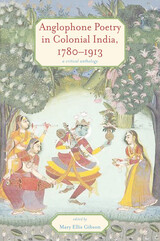
Anglophone Poetry in Colonial India, 1780–1913: A Critical Anthology makes accessible for the first time the entire range of poems written in English on the subcontinent from their beginnings in 1780 to the watershed moment in 1913 when Rabindranath Tagore won the Nobel Prize in Literature.Mary Ellis Gibson establishes accurate texts for such well-known poets as Toru Dutt and the early nineteenth-century poet Kasiprasad Ghosh. The anthology brings together poets who were in fact colleagues, competitors, and influences on each other. The historical scope of the anthology, beginning with the famous Orientalist Sir William Jones and the anonymous “Anna Maria” and ending with Indian poets publishing in fin-de-siècle London, will enable teachers and students to understand what brought Kipling early fame and why at the same time Tagore’s Gitanjali became a global phenomenon. Anglophone Poetry in Colonial India, 1780–1913 puts all parties to the poetic conversation back together and makes their work accessible to American audiences.With accurate and reliable texts, detailed notes on vocabulary, historical and cultural references, and biographical introductions to more than thirty poets, this collection significantly reshapes the understanding of English language literary culture in India. It allows scholars to experience the diversity of poetic forms created in this period and to understand the complex religious, cultural, political, and gendered divides that shaped them.
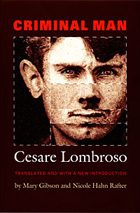
Originally published in 1876, Criminal Man went through five editions during Lombroso’s lifetime. In each edition Lombroso expanded on his ideas about innate criminality and refined his method for categorizing criminal behavior. In this new translation, Mary Gibson and Nicole Hahn Rafter bring together for the first time excerpts from all five editions in order to represent the development of Lombroso’s thought and his positivistic approach to understanding criminal behavior.
In Criminal Man, Lombroso used modern Darwinian evolutionary theories to “prove” the inferiority of criminals to “honest” people, of women to men, and of blacks to whites, thereby reinforcing the prevailing politics of sexual and racial hierarchy. He was particularly interested in the physical attributes of criminals—the size of their skulls, the shape of their noses—but he also studied the criminals’ various forms of self-expression, such as letters, graffiti, drawings, and tattoos. This volume includes more than forty of Lombroso’s illustrations of the criminal body along with several photographs of his personal collection. Designed to be useful for scholars and to introduce students to Lombroso’s thought, the volume also includes an extensive introduction, notes, appendices, a glossary, and an index.
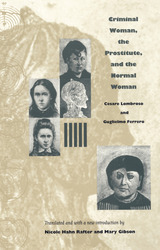
Lombroso’s research took him to police stations, prisons, and madhouses where he studied the tattoos, cranial capacities, and sexual behavior of criminals and prostitutes to establish a female criminal type. Criminal Woman, the Prostitute, and the Normal Woman anticipated today’s theories of genetic criminal behavior. Lombroso used Darwinian evolutionary science to argue that criminal women are far more cunning and dangerous than criminal men. Designed to make his original text accessible to students and scholars alike, this volume includes extensive notes, appendices, a glossary, and more than thirty of Lombroso’s own illustrations. Nicole Hahn Rafter and Mary Gibson’s introduction, locating his theory in social context, offers a significant new interpretation of Lombroso’s place in criminology.
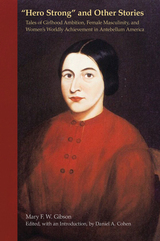
early 1850s as a star writer, under the pseudonym Winnie Woodfern, for more than half a
dozen Boston “story papers,” mass-circulation weekly periodicals that specialized in popular
fiction. Although she would soon join such famous woman authors as Fanny Fern
and E. D. E. N. Southworth as featured contributors to the New York Ledger, America’s
greatest story paper, Gibson’s subsequent output rarely matched the gender-bending creativity
of the tales written in her late teens and early twenties and reprinted in this volume.
But “Hero Strong” and Other Stories does much more than recover the work of a
forgotten literary prodigy. As explained by historian Daniel A. Cohen, Gibson’s tales
also illuminate major interrelated transformations in American girlhood and American
women’s authorship. Challenging traditional gender expectations, thousands of girls of
Gibson’s generation not only aspired to public careers as writers, artists, educators, and
even doctors but also began to experiment with new forms of “female masculinity” in
attitude, bearing, behavior, dress, and sexuality—a pattern only gradually domesticated
by the nonthreatening image of the “tomboy.” Some, such as Gibson, at once realized and
reenacted their dreams on the pages of antebellum story papers.
This first modern scholarly edition of Mary Gibson’s early fiction features ten tales of
teenage girls (seemingly much like Gibson herself) who fearlessly appropriate masculine
traits, defy contemporary gender norms, and struggle to fulfill high worldly ambitions.
In addition to several heroines who seek “fame and riches” as authors or artists,
Gibson’s unconventional protagonists include three female medical students who resort to
grave robbing and a Boston ingénue who dreams of achieving military glory in battle. By
moving beyond “literary domesticity” and embracing bold new models of women’s
authorship, artistry, and worldly achievement, Gibson and her fictional protagonists stand
as exemplars of “the first generation of American girls who imagined they could do almost
anything.”
Daniel A. Cohen is an associate professor of history at Case Western Reserve University.
His previous publications include Pillars of Salt, Monuments of Grace: New England Crime
Literature and the Origins of American Popular Culture, 1674–1860 and ‘The Female Marine’
and Related Works: Narratives of Cross-Dressing and Urban Vice in America’s Early
Republic.
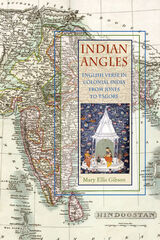
A 2012 CHOICE “Outstanding Academic Title“
A new historical approach to Indian English literature
Mary Ellis Gibson shows that poetry, not fiction, was the dominant literary genre of Indian writing in English until 1860 and that poetry written in colonial situations can tell us as much or even more about figuration, multilingual literacies, and histories of nationalism than novels can. Gibson re-creates the historical webs of affiliation and resistance that were experienced by writers in colonial India—writers of British, Indian, and mixed ethnicities.
Advancing new theoretical and historical paradigms for reading colonial literatures, Indian Angles makes accessible many writers heretofore neglected or virtually unknown. Gibson recovers texts by British women, by nonelite British men, and by persons who would, in the nineteenth century, have been called Eurasian. Her work traces the mutually constitutive history of English-language poets from Sir William Jones to Toru Dutt and Rabindranath Tagore. Drawing on contemporary postcolonial theory, her work also provides new ways of thinking about British internal colonialism as its results were exported to South Asia.
In lucid and accessible prose, Gibson presents a new theoretical approach to colonial and postcolonial literatures.
READERS
Browse our collection.
PUBLISHERS
See BiblioVault's publisher services.
STUDENT SERVICES
Files for college accessibility offices.
UChicago Accessibility Resources
home | accessibility | search | about | contact us
BiblioVault ® 2001 - 2024
The University of Chicago Press









